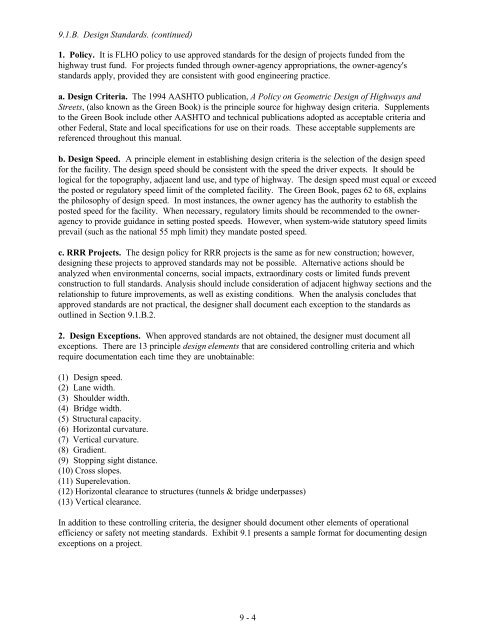FLH PDDM Chapter 9 - Eastern Federal Lands Highway Division
FLH PDDM Chapter 9 - Eastern Federal Lands Highway Division
FLH PDDM Chapter 9 - Eastern Federal Lands Highway Division
You also want an ePaper? Increase the reach of your titles
YUMPU automatically turns print PDFs into web optimized ePapers that Google loves.
9.1.B. Design Standards. (continued)1. Policy. It is <strong>FLH</strong>O policy to use approved standards for the design of projects funded from thehighway trust fund. For projects funded through owner-agency appropriations, the owner-agency'sstandards apply, provided they are consistent with good engineering practice.a. Design Criteria. The 1994 AASHTO publication, A Policy on Geometric Design of <strong>Highway</strong>s andStreets, (also known as the Green Book) is the principle source for highway design criteria. Supplementsto the Green Book include other AASHTO and technical publications adopted as acceptable criteria andother <strong>Federal</strong>, State and local specifications for use on their roads. These acceptable supplements arereferenced throughout this manual.b. Design Speed. A principle element in establishing design criteria is the selection of the design speedfor the facility. The design speed should be consistent with the speed the driver expects. It should belogical for the topography, adjacent land use, and type of highway. The design speed must equal or exceedthe posted or regulatory speed limit of the completed facility. The Green Book, pages 62 to 68, explainsthe philosophy of design speed. In most instances, the owner agency has the authority to establish theposted speed for the facility. When necessary, regulatory limits should be recommended to the owneragencyto provide guidance in setting posted speeds. However, when system-wide statutory speed limitsprevail (such as the national 55 mph limit) they mandate posted speed.c. RRR Projects. The design policy for RRR projects is the same as for new construction; however,designing these projects to approved standards may not be possible. Alternative actions should beanalyzed when environmental concerns, social impacts, extraordinary costs or limited funds preventconstruction to full standards. Analysis should include consideration of adjacent highway sections and therelationship to future improvements, as well as existing conditions. When the analysis concludes thatapproved standards are not practical, the designer shall document each exception to the standards asoutlined in Section 9.1.B.2.2. Design Exceptions. When approved standards are not obtained, the designer must document allexceptions. There are 13 principle design elements that are considered controlling criteria and whichrequire documentation each time they are unobtainable:(1) Design speed.(2) Lane width.(3) Shoulder width.(4) Bridge width.(5) Structural capacity.(6) Horizontal curvature.(7) Vertical curvature.(8) Gradient.(9) Stopping sight distance.(10) Cross slopes.(11) Superelevation.(12) Horizontal clearance to structures (tunnels & bridge underpasses)(13) Vertical clearance.In addition to these controlling criteria, the designer should document other elements of operationalefficiency or safety not meeting standards. Exhibit 9.1 presents a sample format for documenting designexceptions on a project.9 - 4
















